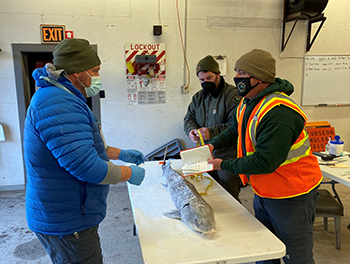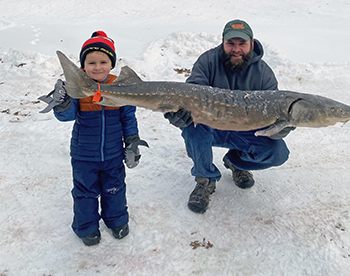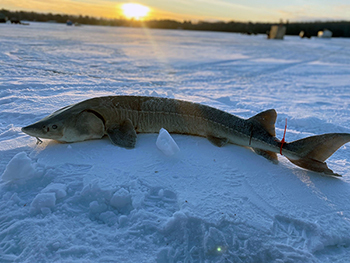Hundreds of sturgeon anglers gather at Black Lake for time-honored tradition
By SIERRA WILLIAMS
Michigan Department of Natural Resources
Michigan’s shortest fishing season keeps getting shorter and shorter as this year’s Black Lake sturgeon harvest concluded after 36 minutes.
While anglers set up their ice shanties on Black Lake (in Cheboygan and Presque Isle counties) in hopes of being one of the few who catch a lake sturgeon, the set up might often take longer than the actual season.
The season opened and closed the morning of Feb. 5.

Over 550 anglers registered for the 2022 Black Lake sturgeon season. Most were from Michigan, but registrations also came in from Wisconsin, Ohio, Pennsylvania and Texas. Participants ranged from solo-anglers and small groups to those who make the season a family affair as a good number of supervised youths participated.
Lake sturgeon, which can weigh up to 200 pounds and live to be 100 years old, are fished in Michigan under strict regulations.
The Michigan Department of Natural Resources has worked closely with other agencies to restore lake sturgeon populations to their native Great Lakes tributaries at several places in the state.
Anglers were initially allocated a season quota of seven sturgeon, but the Michigan Natural Resources Commission set the harvest limit at six fish, at the recommendation of the DNR.
This action helps prevent inadvertent overharvesting by accommodating the expected high number of anglers and anticipates the possibility of near-simultaneous harvest of more than one fish.
|

Successful anglers
The first fish caught during the short sturgeon season on Black Lake was a 59.5-inch female that weighed 48 pounds and was caught by Scott Ash of Onaway. Fish number two, the largest fish, was a 62-inch male that weighed 67 pounds, caught by Matt Barber of Cheboygan.
Fish number three was a 47-inch male that was checked in at 25 pounds and was caught by Jerry Perrin of Augres. Fish four was a 57-inch male that weighed 45 pounds, caught by Doug Blaskowski.
For 19 years, Blaskowski of Brutus has participated in the Black Lake sturgeon season. This was the third year he’s harvested a lake sturgeon out of Black Lake.
“Sturgeon fishing is by far my favorite thing to do,” he said. “This year was special; I had my 3-year-old son with me. He was ready to leave after about two minutes, but I was able to convince him to stay until about 8:23 when we got our fish.”
The fifth fish was a 46-inch male that weighed 23 pounds and was caught by Scott Williams of Millersburg.
|

The sixth fish was a 56-inch male weighing 35 pounds harvested by youth angler, Andrew Maltby who was fishing with his father, Aaron Maltby of Cheboygan.
“I love to fish for sturgeon, especially because it’s something fun to do with my dad,” Andrew Maltby said.
“As soon as the season began the harvest texts were rolling in – fish 1, 2, 3, 4,” said Aaron Maltby. “While talking with Andrew and answering all his questions I noticed a sturgeon coming in right down the middle of the hole. I told Andrew to get ready and he was able to successfully spear the sturgeon. It will be something I will never forget, and it was more fun watching him spear the sturgeon than if I did it myself.”
Black Lake tradition
The lake sturgeon fishing harvest at Black Lake is deeply rooted in the local culture, going back several decades. In 1997, the lake sturgeon population in Black Lake was determined to be well below historical levels, yet still at a level that could withstand a limited annual harvest.
The DNR and multiple partners are striving to rehabilitate the sturgeon population in the entire Inland Waterway through protection, research, education and supplemental stocking. The DNR and local Black Lake chapter of Sturgeon for Tomorrow work together to administer this sturgeon fishery, which helps raise awareness and knowledge of the special management needs of the species.
|

Due to the popularity of the season, extra precautions are taken to prevent illegal fishing activity. DNR conservation officers patrol the ice well in advance to ensure anglers are not fishing for sturgeon before the season begins.
Direct communication with participants is also key to ensure that the season does not go over the set quota. In 2019, the DNR began using a text messaging system so anglers would receive a text when the season began, when each fish was harvested and when the season closed. This helped spread communication in a quick and efficient manner to all anglers and event staff.
Additional efforts are made to restore sturgeon populations and reclaim the historic connection between this fish and people. For over 20 years, the local Black Lake chapter of Sturgeon for Tomorrow has facilitated the annual sturgeon guardian program, which helps protect the fish from being illegally harvested during the six-week spawning season from mid-April to June.
The program has proven that people serving as sturgeon guards watching over the river have helped eliminate poaching, while helping to ensure the protection and reproductive success of the species. Volunteers are assigned shifts along the river to stand watch and report suspicious activity to the DNR conservation officers who also are patrolling the river. The program also uses aerial surveillance to monitor the area.
|

Lake sturgeon rehabilitation has seen ongoing efforts at federal, state, tribal and local levels since the late 1900s, a past century when the species dramatically declined statewide with overharvest, habitat degradation and loss of wild adult populations due to natural causes.
Monitoring of harvesting practices, along with rearing and stocking efforts in selected lakes and rivers, have headlined restoration efforts across the state.
DNR rehabilitation efforts of lake sturgeon in the Cheboygan River watershed, which includes Black Lake, are a cooperative effort involving the DNR, the Bay Mills Indian Community, the Grand Traverse Band of Ottawa and Chippewa Indians, the Little River Band of Ottawa Indians, the Little Traverse Bay Bands of Odawa Indians and the Sault Ste. Marie Tribe of Chippewa Indians, the Black Lake Chapter of Sturgeon for Tomorrow, Michigan State University and the Tower-Kleber Limited Partnership.
For more information on lake sturgeon in Michigan, visit Michigan.gov/Sturgeon.
|
Check out previous Showcasing the DNR stories in our archive at Michigan.gov/DNRStories. To subscribe to upcoming Showcasing articles, sign up for free email delivery at Michigan.gov/DNR.
Note to editors: Contact: John Pepin, Showcasing the DNR series editor, 906-226-1352. Accompanying photos and a text-only version of this story are available below for download. Caption information follows. Credit Michigan Department of Natural Resources, unless otherwise noted.
Text-only Showcasing Story - Black Lake sturgeon season
Barber: A lake sturgeon caught by Matt Barber of Cheboygan at the 2022 Black Lake sturgeon season, the largest fish of the day.
Blaskowski: Doug Blaskowski of Brutus caught the fourth sturgeon at the 2022 Black Lake sturgeon season with his 3-year-old son by his side. Fish four was a 57-inch male that weighed 45 pounds.
Capture: A scene from Michigan Department of Natural Resources efforts to capture spring spawning lake sturgeon for egg collection and tagging in the Sturgeon River in Baraga County, part of the DNR’s sturgeon rehabilitation efforts.
Maltby: Andrew Maltby caught the sixth sturgeon at the 2022 Black Lake sturgeon season with his father, Aaron Maltby, by his side. The sixth fish was a 56-inch male that weighed 35 pounds.
Morning: The 2022 Black Lake sturgeon season began at 8 a.m. on Black Lake in Cheboygan and Presque Isle counties.
Register: Anglers who harvested a sturgeon during the Black Lake sturgeon season registered their fish at the Michigan Department of Natural Resources field office in Onaway.
Release: Ed Baker, a Michigan Department of Natural Resources fisheries research biologist, releases young lake sturgeon into the Whitefish River in Delta County. The sturgeon were reared in a streamside facility upstream.
Sturgeon: A male lake sturgeon in the Sturgeon River in Baraga County during a multiagency effort to collect eggs from spawning female sturgeon for continued rehabilitation of the species in Michigan.
|